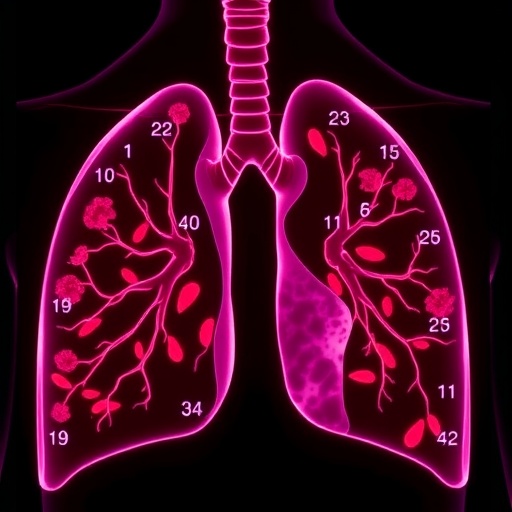Immunotherapy Concurrently Administered with Chemoradiotherapy Shows Promise in Limited-Stage Small-Cell Lung Cancer
Limited-stage small-cell lung cancer (LS-SCLC) has long posed a significant therapeutic challenge, with minimal advancements in treatment improving patient outcomes over the past several decades. A groundbreaking study recently published in BMC Cancer delivers encouraging data on the combined use of immune checkpoint inhibitors (ICIs) alongside concurrent chemoradiotherapy (cCRT), potentially marking a pivotal shift in LS-SCLC management.
LS-SCLC, characterized by cancer confined to one side of the chest and regional lymph nodes, has traditionally been treated with a combination of chemotherapy and radiotherapy. Despite aggressive treatment, relapse rates remain high and overall survival limited. Immune checkpoint inhibitors, which have transformed the treatment landscape for several malignancies by harnessing the body’s immune system, were until recently unexplored in this setting for concurrent administration with cCRT.
.adsslot_jFHlXv9kzM{width:728px !important;height:90px !important;}
@media(max-width:1199px){ .adsslot_jFHlXv9kzM{width:468px !important;height:60px !important;}
}
@media(max-width:767px){ .adsslot_jFHlXv9kzM{width:320px !important;height:50px !important;}
}
ADVERTISEMENT
The recent study enrolled 29 patients diagnosed with LS-SCLC who received a treatment protocol combining etoposide and platinum-based chemotherapy concurrently with radiotherapy delivered either once daily as 60 Gy over 30 fractions or twice daily at 45 Gy over 30 fractions. Uniquely, ICIs were introduced concurrently from the onset of chemoradiotherapy and continued as maintenance therapy for up to two years post-treatment. This approach sought to maximize tumor eradication during the critical treatment window while sustaining long-term immune activation.
After a median follow-up of over two years, results demonstrated a median progression-free survival (PFS) of 13.1 months and a robust two-year PFS rate of 40%. More impressively, median overall survival (OS) had not yet been reached, with nearly 70% of patients alive at two years—a notable improvement over historical controls for LS-SCLC. The objective response rate was substantial, with 72.4% of patients showing measurable tumor shrinkage, underscoring the potential synergistic effect of integrating ICIs with the standard chemoradiotherapy backbone.
Safety analyses were critical, given the intensified immunotherapy exposure alongside chemoradiotherapy’s known toxicities. Encouragingly, no treatment-related deaths (grade 5 toxicities) were observed. Nonetheless, there was a heightened incidence of pneumonitis, with grade 3 severity affecting 10.3% of patients, which is notably higher than typical rates reported in isolated immunotherapy or chemoradiotherapy. Esophagitis, a common side effect of thoracic radiation, occurred in nearly three-quarters of patients but was exclusively mild to moderate (grade 1–2), demonstrating that concurrent ICIs did not exacerbate this typical toxicity.
Neutropenia, a dangerous decrease in key white blood cells, appeared in a small subset with grade 4 severity (10.3%) but remained manageable with supportive care strategies. A singular grade 3 allergic reaction was recorded. These side effect profiles emphasize the necessity for meticulous patient monitoring and judicious selection of candidates who might benefit most from this intensified therapeutic regimen.
This study’s findings provide compelling evidence that the addition of ICIs concurrently with cCRT enhances clinical outcomes without disproportionately increasing debilitating toxicities. The integration of immune modulation appears to potentiate standard chemoradiotherapy effects, possibly by invigorating cytotoxic T-cell responses during and after radiation-induced tumor antigen release. This combined modality might disrupt tumor microenvironment immunosuppression, thereby sustaining long-term antitumoral immunity.
Despite promising early results, the relatively high incidence of clinically significant pneumonitis urges caution. Pneumonitis, an inflammatory lung reaction, can be life-threatening and complicates treatment continuation. Future investigations should aim to identify biomarkers predictive of pulmonary toxicity to tailor therapy and minimize adverse effects.
Moreover, the study’s design, involving radiotherapy fractionation variation (once versus twice daily), provides intriguing insights into optimizing dosing schedules with immunotherapy. Prospective trials could delve deeper into whether radiotherapy timing influences immunotherapy efficacy or toxicity, potentially enabling personalized radiotherapy regimens that synergize best with ICIs.
As immunotherapy becomes a mainstay in oncology, this research importantly extends its applicability to LS-SCLC, a historically hard-to-treat entity. With continued follow-up, overall survival data will clarify the durability of benefit these patients may realize. If outcomes hold, this combination approach could establish a new standard of care for LS-SCLC that transcends decades of stagnation.
Further multicenter randomized trials with larger patient cohorts are necessary to validate these encouraging results conclusively. Given the moderate sample size and single-arm nature of the study, comparative data against cCRT alone will elucidate the precise incremental advantages and long-term safety profile of concurrent ICIs.
In summary, the concurrent administration of immune checkpoint inhibitors with chemoradiotherapy represents a transformative therapeutic frontier for LS-SCLC. The synergy achieved enhances tumor control and extends landmark survival milestones, which traditionally have been elusive in this patient population. However, carefully balancing efficacy with the risk of immune-related adverse events like pneumonitis will be paramount.
Clinicians and researchers alike anticipate future studies to refine patient selection, optimize dosing schedules, and integrate novel biomarkers that predict response and toxicity. Harnessing the immune system alongside traditional cytotoxic therapies could finally tip the scales in favor of sustained remission and improved quality of life for patients confronting limited-stage small-cell lung cancer.
This pioneering research signals a hopeful horizon where immunotherapy is no longer reserved only for extensive-stage disease but becomes an integral part of early, potentially curative LS-SCLC treatment strategies. Patients and providers should watch closely as the oncology community continues to unravel the complex interplay between radiation, chemotherapy, and the immune microenvironment to unlock durable cancer control.
— End of article
Subject of Research: Therapeutic efficacy and safety of concurrent immune checkpoint inhibitors with chemoradiotherapy in limited-stage small-cell lung cancer.
Article Title: Immunotherapy concurrently administered with chemoradiotherapy in limited-stage small-cell lung cancer.
Article References:
Long, L., Jiang, L., Teng, Y. et al. Immunotherapy concurrently administered with chemoradiotherapy in limited-stage small-cell lung cancer.
BMC Cancer 25, 1077 (2025). https://doi.org/10.1186/s12885-025-14480-7
Image Credits: Scienmag.com
DOI: https://doi.org/10.1186/s12885-025-14480-7
Tags: Chemoradiotherapy for Limited-Stage CancerCombined Cancer Therapy Approachesconcurrent chemoradiotherapy benefitsEtoposide and Platinum-Based ChemotherapyHigh Relapse Rates in Small-Cell Lung Cancerimmune checkpoint inhibitors in oncologyImmunotherapy in Small-Cell Lung CancerInnovative Treatment Strategies for Lung CancerLS-SCLC Treatment AdvancesMaintenance Therapy in Cancer TreatmentPatient Outcomes in LS-SCLC TreatmentRadiotherapy in Lung Cancer Management





